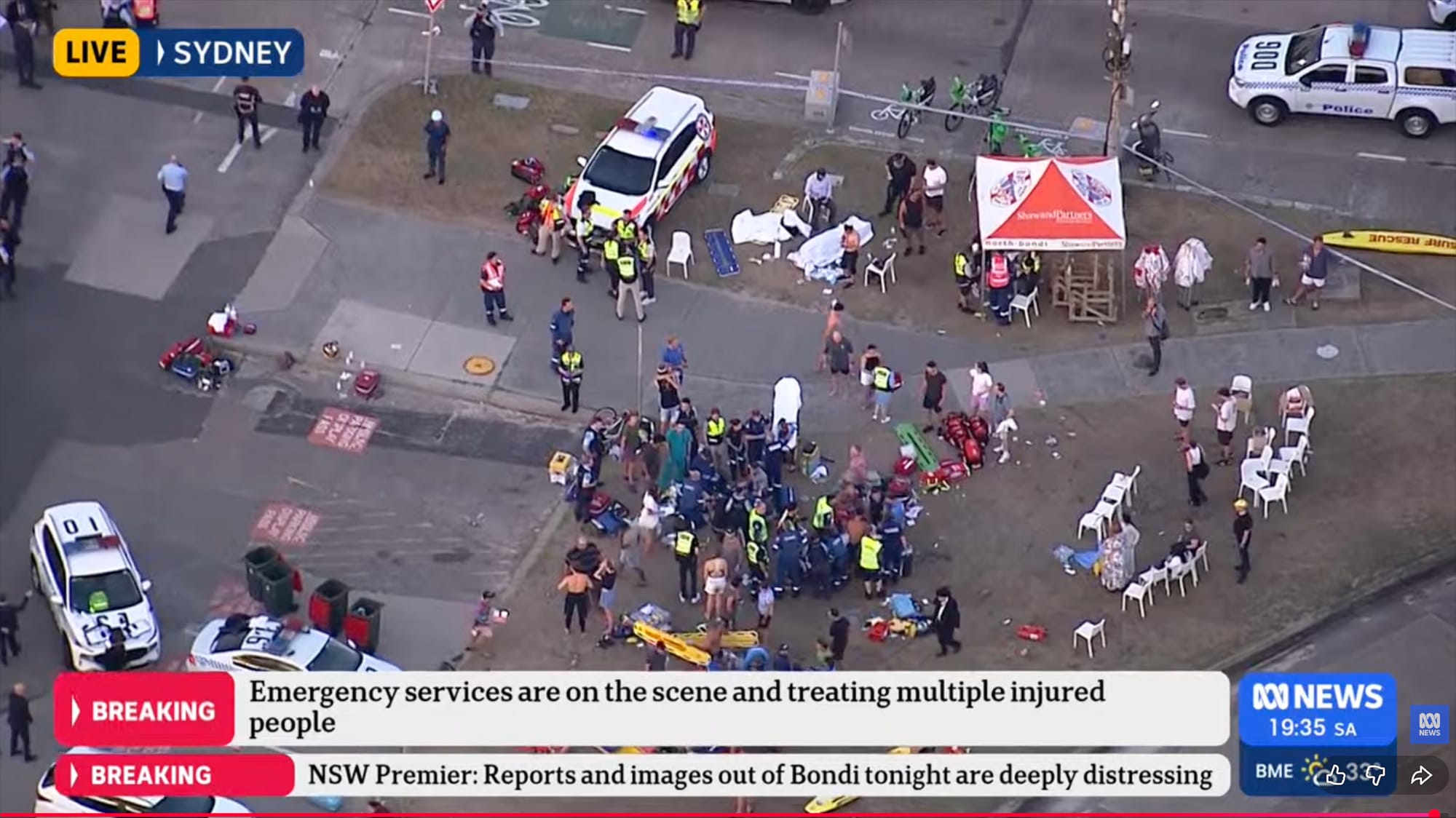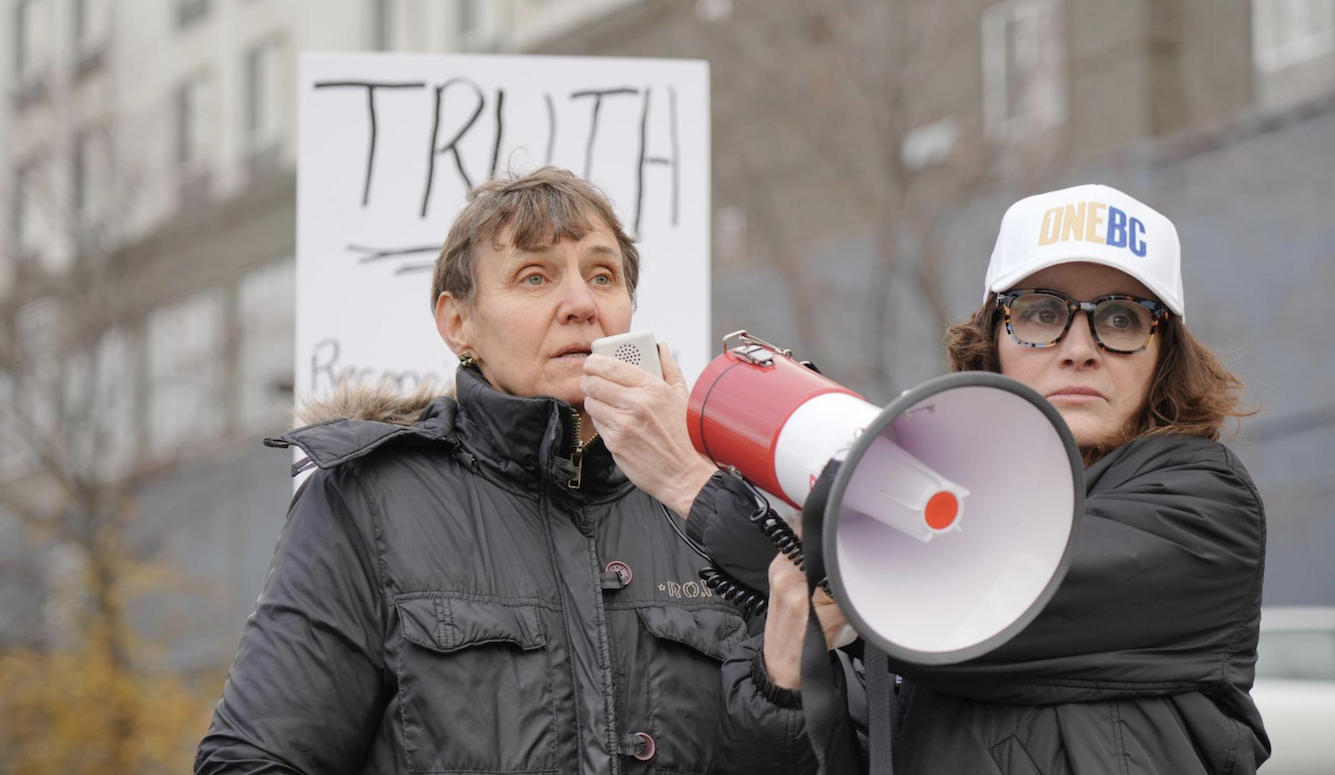COVID-19
COVID-19 Superspreader Events in 28 Countries: Critical Patterns and Lessons
In the absence of any comprehensive database of COVID-19 superspreading events, I built my own.

In 1899, a German bacteriologist named Carl Flügge proved that microbes can be transmitted ballistically through large droplets that emit at high velocity from the mouth and nose. His method for proving the existence of these “Flügge droplets” (as they came to be known) was to painstakingly count the microbe colonies growing on culture plates hit with the expelled secretions of infected lab subjects. It couldn’t have been pleasant work. But his discoveries saved countless lives. And more than 12 decades later, these large respiratory droplets have been identified as a transmission mode for COVID-19.
Flügge’s graduate students continued his work into the 20th century, experimenting with different subjects expelling mucosalivary droplets in different ways. Eventually they determined, as a 1964 report in the Proceedings of the Royal Society of Medicine put it, that the quantity of expelled Flügge droplets varies markedly based on the manner of respiration: “Very few, if any… droplets are produced during quiet breathing, but [instead, they] are expelled during activities such as talking, coughing, blowing and sneezing.” A single heavy cough, it is now known, can expel as much as a quarter teaspoon of fluid in the form of Flügge droplets. And the higher the exit velocity of the cough, the larger the globules that can be expelled.
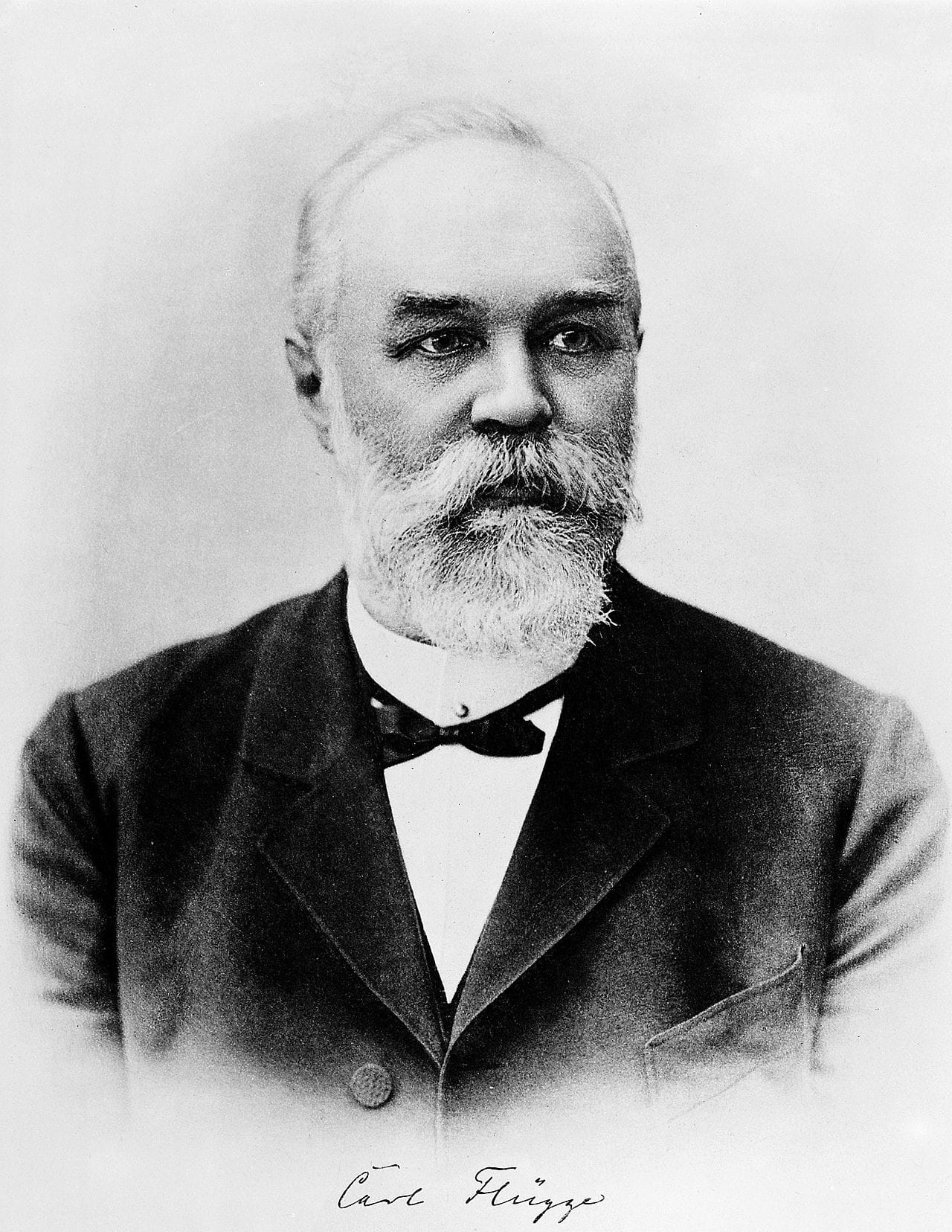
Yet if Flügge were with us today, he might be surprised by how little his science has been usefully advanced over the last few generations. As Lydia Bourouiba of the MIT Fluid Dynamics of Disease Transmission Laboratory recently noted in JAMA Insights, the basic framework used to represent human-to-human transmission of respiratory diseases such as COVID-19 remain rooted in the tuberculosis era. According to the binary model established in the 1930s, droplets typically are classified as either (1) large globules of the Flüggian variety—arcing through the air like a tennis ball until gravity brings them down to Earth; or (2) smaller particles, less than five to 10 micrometers in diameter (roughly a 10th the width of a human hair), which drift lazily through the air as fine aerosols.
In a fascinating paper published on March 26th, Turbulent Gas Clouds and Respiratory Pathogen Emissions: Potential Implications for Reducing Transmission of COVID-19, Bourouiba shows that analyzing a human sneeze is unusually difficult, even by the standards of fluid dynamics (whose mathematics I once modeled in my former capacity as an engineer and computer programmer). That’s because those mucosalivary droplets we emit are cocooned within a warm, moist enveloping gas cloud—Bourouiba calls it a “puff”—that protects the droplets from evaporation and allows even small globules to travel much farther than one might otherwise predict. The binary distinction between large and small droplets remains fundamental: Eventually, the big particles fall while the smaller ones don’t. But during those first fractions of a second when a sneeze (or cough, or shout) is expelled, Bourouiba shows, the enveloping gas sheath allows smaller particles to act, ballistically speaking, as if they were larger.
The science here is mind-bogglingly complex, because modeling the puff’s behaviour requires that Bourouiba and her team model not only the dynamics of the puff as it travels and dissipates, but also the biophysical and thermodynamic processes unfolding within the gas cloud. But the overall upshot is that such a puff “and its payload of pathogen-bearing droplets of all sizes” can travel seven to eight meters—about four times the length of the six-foot social-distancing buffer zone we’ve all been taught to enforce since mid-March.
Bourouiba’s research hits squarely on a blind spot in our knowledge of COVID-19. On one hand, scientists have an intimate molecule-by-molecule knowledge of the virus’s structure, its full genome having been sequencedmonths ago. On the other hand, the scientific and lay literature is bursting with epidemiological reports from just about every corner of the planet. But the nitty-gritty mechanics of actual disease transmission doesn’t take place on the microscopic scale of nucleic acids or on the gargantuan scale of whole nations. It takes place on the everyday face-to-face scale of inches and feet, as Flügge showed 121 years ago.
And it is on this crucial scale that our knowledge is thinnest. Despite the passage of four months since the first known human cases of COVID-19, our public-health officials remain committed to policies that reflect no clear understanding as to whether it is one-off ballistic droplet payloads or clouds of fine aerosols that pose the greatest risk—or even how these two modes compare to the possibility of indirect infection through contaminated surfaces (known as “fomites”).
Gaining such an understanding is absolutely critical to the task of tailoring emerging public-health measures and workplace policies, because the process of policy optimization depends entirely on which mechanism (if any) is dominant:
- If large droplets are found to be a dominant mode of transmission, then the expanded use of masks and social distancing is critical, because the threat will be understood as emerging from the ballistic droplet flight connected to sneezing, coughing, and laboured breathing. We would also be urged to speak softly, avoid “coughing, blowing and sneezing,” or exhibiting any kind of agitated respiratory state in public, and angle their mouths downward when speaking.
- If lingering clouds of tiny aerosol droplets are found to be a dominant mode of transmission, on the other hand, then the focus on sneeze ballistics and the precise geometric delineation of social distancing protocols become somewhat less important—since particles that remain indefinitely suspended in an airborne state can travel over large distances through the normal processes of natural convection and gas diffusion. In this case, we would need to prioritize the use of outdoor spaces (where aerosols are more quickly swept away) and improve the ventilation of indoor spaces.
- If contaminated surfaces are found to be a dominant mode of transmission, then we would need to continue, and even expand, our current practice of fastidiously washing hands following contact with store-bought items and other outside surfaces; as well as wiping down delivered items with bleach solution or other disinfectants.
Unfortunately, the available international data hasn’t been particularly helpful in addressing this inquiry. Every nation is reporting its data in a different way. And to my knowledge, no one has produced a comprehensive international database of large COVID-19 infection clusters—or “superspreading events” (SSEs), as they are sometimes referred to in the scientific literature—which would facilitate a systematic study of the forms of behaviour that spread the disease most rapidly. As SSE expert Richard Stein put it in a definitive 2011 article, roughly “20% of the individuals within any given population are thought to contribute at least 80% to the transmission potential” of typical pathogens.
In the absence of any comprehensive database of COVID-19 superspreading events, I built my own, cataloguing 58 SSEs in 28 different countries (plus ships at sea). As there is no formal scientific definition of SSE at play, nor any World Health Organization-established protocol for cataloguing them, I simply spent several weeks scanning the scientific and lay press for any information I could find, using search terms such as “superspreader,” “cluster,” “hot spot”; or non-English variants, such as superpropagadore. I also made abundant inquiries to personal and professional contacts through email and social media, seeking to unearth examples that hadn’t been reported in the mass media or scientific journals. That process will continue, and I am appreciative of readers who send me information I may have missed. (April 27 Update: New information about cases I have added may be found on this thread.)
I am not an epidemiologist, let alone a virologist. And the data I am working with is substandard anyway, as there are all sorts of obvious selection biases at play, including the editorial biases of the journalists on whom I rely for local reports. In some countries, such as South Korea, COVID-19 contact tracing is meticulous. In other places, it’s virtually non-existent. Some relatively small SSEs—such as the Chicago cluster surrounding the superspreader designated by the US Centers for Disease Control as A1.1—are documented by dozens of different sources. Yet many much larger SSEs, which have infected hundreds or even thousands of people, remain only vaguely described in the literature.
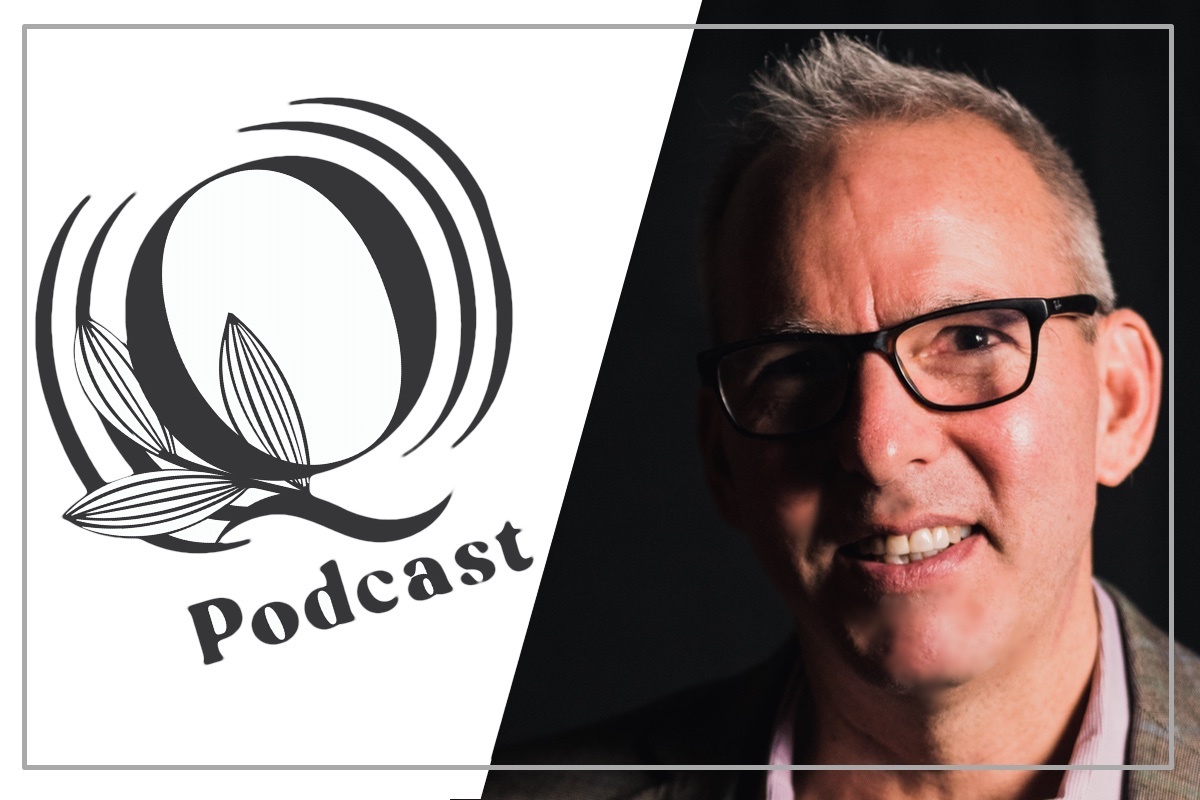
In some cases, I found it hard to get even the most basic information—such as the number of individuals believed to have been infected or killed by an SSE. This is one reason why I didn’t impose a hard cut-off in regard to either index, and instead based my inclusion on whether credible local sources presented the cluster as epidemiologically noteworthy.
There are no doubt hundreds, or even thousands, of SSEs that simply have never been reported, and never will be. And so it is impossible to determine what overall share of global COVID-19 cases are attributable to SSEs. To cite one example: Was Liverpool’s March 11 football match against Atletico Madrid an SSE, as many believe? Possibly. But no one knows, because the study of COVID-19 SSEs is bedevilled by the same sloppy contact-tracing practices and inadequate testing resources as has hampered the public-health response to the disease more generally.
Another research frustration lies with the fact that even countries that employ competent contact-tracing methods—such as Australia and New Zealand—withhold important information from publication for privacy reasons. (There is a “hospitality worker” in Victoria, for instance, whose case seems particularly interesting. But I have been unable to find detailed information about the events and venues at which he infected others.) In other cases, I’ve received private correspondence whose contents I’ve chosen to exclude from my database—involving Purim parties in Israel, for instance, and a Swedish party at which a whistle apparently was passed around—because the information can’t be corroborated through public sources.
I also chose to exclude examples from some countries that have blocked or distorted information about SSEs. It is widely known, for instance, that large officially-sanctioned religious gatherings in the Iranian city of Qom led to massive outbreaks in February. But no adequately reliable data or public reporting exists as to the extent. The same is true of the outbreaks that reportedly have broken out amongst the political leadership in Afghanistan. The Chinese literature is full of fascinating examples (including one from a restaurant in Guangdong Province that I discuss in some detail later on). But China’s policy of selective disclosure and, in some cases, outright dishonesty, has made me skeptical of many reported details.
Finally, I have chosen to exclude SSEs that center on hospitals and old-age homes, despite the fact that in many countries (including Canada, where I live), these comprise the main spawning ground for COVID-19. This is because the purpose of this exercise is to gain information about the relative effects of three broad modes of COVID-19 transmission—large droplets transmitted ballistically, persistent concentrations of tiny airborne droplets, and contaminated surfaces. In hospitals and old-age homes, all three of these mechanisms are almost invariably at play—as these tend to be shared spaces full of commonly touched surfaces and close interpersonal contact among residents and staff. And so such SSEs serve to inflate the size of the database without providing assistance in isolating variables. The same principle is true of COVID-19 transmission within households (and possibly prisons), which is why I have excluded intra-household clusters as well.
Only 38 of the 58 SSEs that I recorded were documented in a way that permitted me to determine their date with any specificity. (And even in these cases, I sometimes had to make educated estimates because of the vague nature of the reporting.) In the case of multi-day SSEs, such as religious festivals, I picked a day corresponding to the middle of the event. Unfortunately, some of the largest SSEs, such as those at North American meat processing plants, can’t be usefully pinpointed at all because the infections span multiple weeks (or even months), and the employers haven’t released detailed date-tagged data.
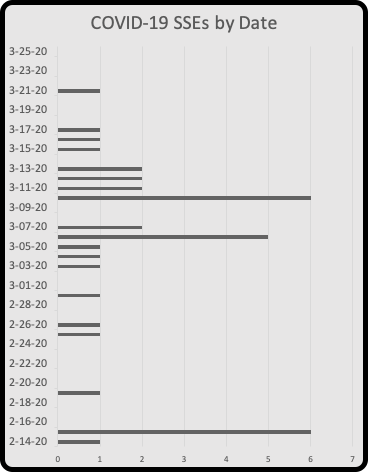
Of the 38 SSEs for which dates could be usefully identified, about 75 percent (29/38) took place in the 26-day span between February 25th and March 21st, roughly corresponding to the period when thousands of infected COVID-19 individuals were already traveling around the world, but before social distancing and event-cancelation policies had been uniformly implemented in many of the affected countries. (A notable early outlier is Steve Walsh, who spread COVID-19 from a Singapore corporate meeting to a French ski resort to his native UK in late January and early February.) No doubt, a vast number of SSEs occurred in January and February without being reported as such, because public-health officials and journalists weren’t alive to the nature or scale of the coming pandemic. But it is reassuring that, so far, April has been almost entirely bereft of publicly reported SSEs.
I was struck by how few of the SSEs originated in conditions stereotypically associated with the underclass (though a March outbreak at a Qatari migrant workers camp in the industrial area north of Doha offers one such example). Many of the early SSEs, in fact, centered on weddings, birthday parties, and other events that were described in local media as glamorous or populated by “socialites.” Examples here include a March 7th engagement party at a Rio de Janeiro “mansion” that attracted “high society” fly-ins from around the world, and a similarly described birthday party in Westport, CT.
It is theoretically possible that socioeconomically privileged individuals really do lack some immune-response mechanism that protects individuals who have been exposed to a wider array of infectious pathogens. A recent report on COVID-19 surveillance testing at a Boston homeless shelter, for instance, contained the stunning disclosure that 36 percent of 408 screened individuals tested positive for COVID-19. Yet the vast majority were asymptomatic, and even the few who were symptomatic did not diverge statistically from the 64 percent of tested individuals who were COVID-19-negative.
But absent more data, the more obvious explanation is that these early SSEs are linked to the intercontinental travel practices of the guests. In the case of the Connecticut event, reports the New York Times, “a visitor from Johannesburg—a 43-year-old businessman—fell ill on his flight home.” And the Rio party was attended by guests who’d traveled recently from, or through New York, Belgium and Italy. And in the case of Iceland, a March 12 journalistic report concludes that the disease came to the island “from upper-class Icelanders who could afford to travel to Italy and Austria for a ski trip in the Alps in February. Almost 80% of the infected were Icelandic ski tourists or connected to them.” Moreover, COVID-19 outbreaks in poor communities are simply less likely to be reported, because the victims have less access to testing, high-end medical care, or media contacts.
In fact, the truly remarkable trend that jumped off my spreadsheet has nothing to do with the sort of people involved in these SSEs, but rather the extraordinarily narrow range of underlying activities. And I believe it is on this point that a close study of SSEs, even one based on such a biased and incomplete data set as the one I’ve assembled in my lay capacity, can help us:
- Of the 54 SSEs on my list for which the underlying activities were identified, no fewer than nine were linked to religious services or missionary work. This includes massive gatherings such as February’s weeklong Christian Open Door prayer meeting in Mulhouse, France, which has been linked to an astounding 2,500 cases; and a massive Tablighi Jamaat Islamic event in Lahore that attracted a quarter-million people. But it also includes much smaller-scale religious activities, such as proselytizing in rural Punjabi villages and a religious meeting in a Calgary home.
- Nineteen of the SSEs—about one-third—involved parties or liquor-fueled mass attendance festivals of one kind or another, including (as with the examples cited above) celebrations of weddings, engagements and birthdays.
- Five of the SSEs involved funerals.
- Six of the SSEs involved face-to-face business networking. This includes large-scale events such as Biogen’s notorious Boston leadership meeting in February, as well as one-on-one business meetings—from the unidentified “traveling salesperson” who spread COVID-19 in Maine to Hisham Hamdan, a powerful sovereign-wealth fund official who spread the disease in Malaysia.
All told, 38 of the 54 SSEs for which activities were known involved one or more of these four activities—about 70 percent. Indeed, the categories sometimes overlap, as with patient A1.1 in Chicago, who attended both a party and a funeral in the space of a few days; or the New Rochelle, NY man who covered the SSE trifecta of Bar Mitzvah party, synagogue services, and local funeral, all the while going to his day job as a lawyer in New York City.
But even that 70 percent figure underestimates the prevalence of these activities in COVID-19 SSEs, because my database also includes five SSEs involving two warships and three cruise ships—the USS Roosevelt, Charles de Gaulle, Diamond Princess, Grand Princess and Ruby Princess—at least three of which (and probably all five) featured onboard parties.
These parties, funerals, religious meet-ups and business networking sessions all seem to have involved the same type of behaviour: extended, close-range, face-to-face conversation—typically in crowded, socially animated spaces. This includes the many people infected by a bartender while being served at a raucous après ski venue in Austria, and party guests in Brazil greeting “each other with two kisses on the cheek [a local custom], hugs and handshakes.” The funerals in question are generally described as highly intimate and congested scenes of grieving among close friends and relatives. In the case of the SSE funeral in Albany, Georgia that devastated the local population, “people wiped tears away, and embraced, and blew their noses, and belted out hymns. They laughed, remembering. It was a big gathering, with upward of 200 mourners overflowing the memorial chapel, so people had to stand outside.”
With few exceptions, almost all of the SSEs took place indoors, where people tend to pack closer together in social situations, and where ventilation is poorer. (It is notable, for instance, that the notorious outbreak at an Austrian ski resort is connected to a bartender and not, say, a lift operator.) For what it’s worth, this is consistent with the reported pattern in China. But generalizations in this area are complicated by the fact that some of the religious festivals described herein were mixed indoor/outdoor affairs. (Moreover, the February 19 SSE at San Siro stadium in Milan is also ambiguous, since that stadium has a roof over the seating area, but not over the field—and thousands of the fans spent hours bouncing around bars in and around Milan.)
The media accounts of these SSEs are full of descriptions that emphasize their socially intimate nature. At a February 15 festival in Gangelt, a town in Germany’s tiny Heinsberg district, “beer and wine flowed aplenty as approximately 350 adults in fancy dress locked arms on long wooden benches and swayed to the rhythm of music provided by a live band. During an interval in the programme, guests got up to mingle with friends and relatives at other tables, greeting each other as Rhineland tradition commands, with a bützchen, or peck on the cheek.” Since that time, more than 40 Germans from the Heinsberg district have died. It’s been called “Germany’s Wuhan.”
In the case of religious SSEs, Sikhs, Christians, Jews and Muslims are all represented in the database. The virus makes no distinction according to creed, but does seem to prey on physically intimate congregations that feature some combination of mass participation, folk proselytizing and spontaneous, emotionally charged expressions of devotion. In the case of Islam, it is notable that the same movement, Tablighi Jamaat, has been responsible for massive outbreaks at completely separate events in Lahore(noted above), Delhi and Kuala Lampur. At Mulhouse, the week’s schedule included Christian “choir performances, collective prayer, singing, sermons from preachers, workshops, and testimony from people who said God had cured their illnesses… Many people came day after day, and spent hours there.” And in Punjab, dozens of Sikhs died thanks to the itinerant rural preaching of a single (now deceased) infamous septuagenarian named Baldev Singh (whose deadly travels inspired a hit Punjabi song by Sidhu Moose Wala, linked immediately below).
Of the 54 SSEs for which underlying activities could be identified, only 11 did not involve either religious activity, a party, a funeral, a cruise or extended face-to-face professional networking. But even in this minority of cases, one can observe almost identical interpersonal dynamics. Three of the SSEs—in Japan, Skagit County, WA, and Singapore—involved concert-goers and singing groups belting out tunes together over a period of hours. (The Skagit example is particularly interesting, because the organizers were aware of the COVID-19 risk beforehand, and took the precaution of spacing out the participants by several feet. If they had been merely chatting, instead of singing, no one might have gotten sick.)
Another SSE involved a group of Canadian doctors engaged in a day of recreational curling. This is a sport that involves hyperventilating participants frenetically sweeping the ice with brooms while their faces are positioned inches apart, sometimes changing partners—an ideal climate for Flüggian infection. Indeed, this partner-swapping aspect of the activity seems to be a common feature of many suspected SSEs, such as square-dancing parties.
Four of the SSEs were outbreaks at meat-processing plants, in which “gut snatchers” and other densely packed workers must communicate with one another amidst the ear-piercing shriek of industrial machinery. I lack the expertise to determine how the refrigerated nature of some meat-processing facilities may affect the dynamics of droplet transmission—though I would also note that at least four of the SSEs on my list unfolded at European ski resorts. But high levels of noise do seem to be a common feature of SSEs, as such environments force conversationalists to speak at extremely close range. (Related factors may be at play in old-age homes. These tend to be quiet places. But the reduced speaking volume and hearing functions of some elderly residents lend themselves to conversations held at much closer range than is socially typical in the general population.)
Finally, three of the SSEs involved mass sports spectacles, during which fans regularly rain saliva in all directions as they communally celebrate or commiserate in response to each turn of fortune. (Advance to the 8:30 mark of this video, showing euphoric hometown fan reaction during the infamous February 19th football match between Atlalanta and Valencia, and you will see exactly what I mean.) As we now know, the danger starts even before the action begins: One of the most dangerous things you can do at a sports event in the COVID-19 era is sing the national anthem.
When do COVID-19 SSEs happen? Based on the list I’ve assembled, the short answer is: Wherever and whenever people are up in each other’s faces, laughing, shouting, cheering, sobbing, singing, greeting, and praying. You don’t have to be a 19th-century German bacteriologist or MIT expert in mucosalivary ballistics to understand what this tells us about the most likely mode of transmission.
It’s worth scanning all the myriad forms of common human activity that aren’t represented among these listed SSEs: watching movies in a theater, being on a train or bus, attending theater, opera, or symphony (these latter activities may seem like rarified examples, but they are important once you take stock of all those wealthy infectees who got sick in March, and consider that New York City is a major COVID-19 hot spot). These are activities where people often find themselves surrounded by strangers in densely packed rooms—as with all those above-described SSEs—but, crucially, where attendees also are expected to sit still and talk in hushed tones.
The world’s untold thousands of white-collar cubicle farms don’t seem to be generating abundant COVID-19 SSEs—despite the uneven quality of ventilation one finds in global workplaces. This category includes call centers (many of which are still operating), places where millions of people around the world literally talk for a living. (Addendum: there are at least two examples of call-centre-based clusters, both of which were indicated to me by readers after the original version of this article appeared—one in South Korea, which overlaps with the massive Shincheonji Church of Jesus cluster;and the other in Jamaica.)
In New Zealand, one SSE centered on students at a girls’ school. Given the exuberant and socially intimate way in which children laugh, argue and gossip, I am surprised there are not more schools on my list. Moreover, I had trouble finding any SSEs that originated in university classrooms, which one would expect to be massive engines of infection if COVID-19 could be transmitted easily through airborne small-droplet diffusion.
In the United States, the two university-based examples that have received the most media attention are Liberty University in Lynchburg, Va. and the University of Texas. But in neither case was there any apparent connection to classroom activity. At Liberty, where several employees got sick, the one student known to be infected isn’t even currently enrolled in classes. And the UT outbreak, which has caused more than 40 students to be infected, actually took place on a Spring Break trip to Mexico. It’s possible, I suppose, that these students spent the week holed up in a conference room with a stack of books. But my instincts indicate otherwise.
It’s similarly notable that airplanes don’t seem to be common sites for known SSEs, notwithstanding the sardine-like manner in which airlines transport us and the ample opportunity that the industry’s bureaucracy offers for contact tracing. I have been made aware of a Vietnamese woman who apparently spread infection on a flight. And New Zealand has one cluster that’s based around an infected but asymptomatic flight attendant. But the many known infections he caused took place at a wedding reception, not in an airplane. This flight attendant was running what was, in effect, an unintended experiment, with the passengers on board his aircraft playing the role of control group. And the results offer a microcosm of the nature of SSEs as a whole.
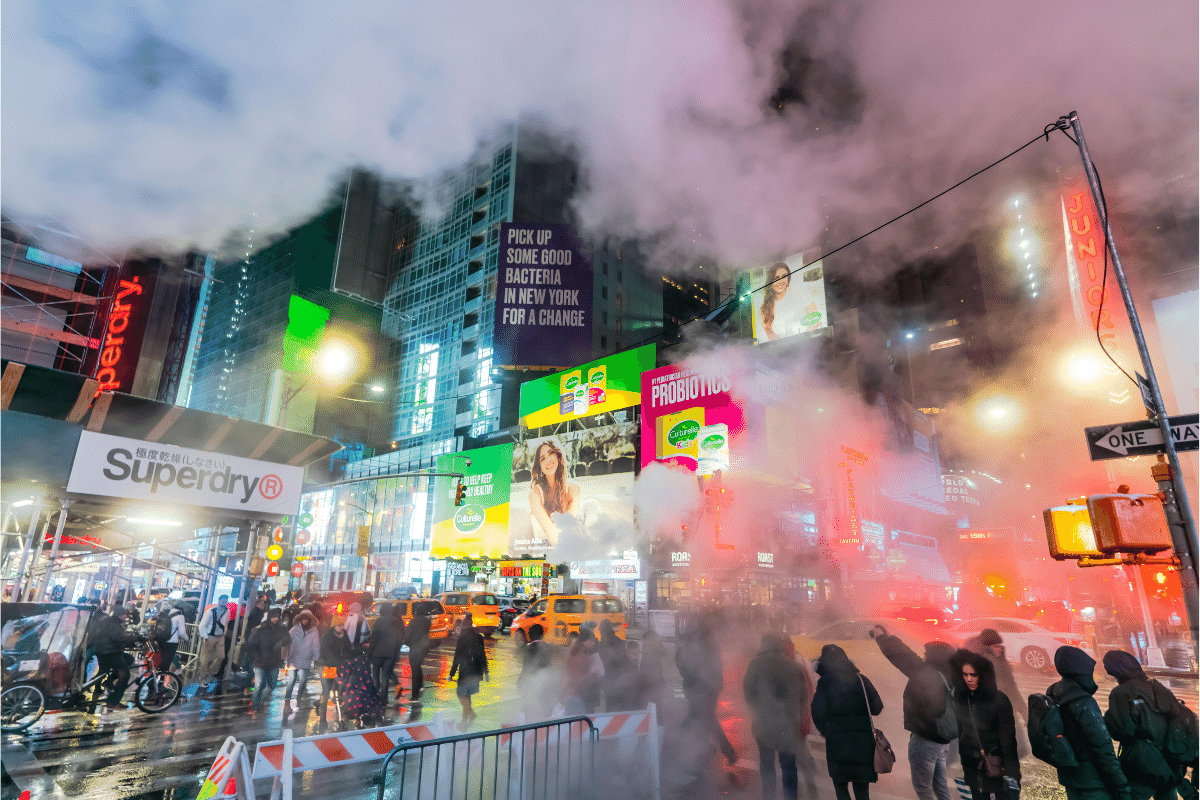
I’ve already cataloged the limitations of my approach at some length. And I will emphasize again that I am not an epidemiologist, virologist, or infectious-diseases expert (though I like to think I’ve made myself a somewhat educated reader of the most recently published scientific literature in these fields). But even a layperson can see that there is a fairly clear pattern in the most notorious, destructive, and widely reported cases of mass COVID-19 infection—virtually all of which feature forms of human behaviour that permit the direct ballistic delivery of a large-droplet Flüggian payload from face A to face B. If fomites were a major pathway for COVID-19 infection outside of hospitals, old-age residences, and homes, one would expect restaurant cooks, mass-transit ticket handlers, and FedEx delivery workers to be at the center of major clusters. They’re not. If small-droplet airborne concentrations in unventilated spaces were a common vector for COVID-19 transmission (as with measles, for instance), one would expect whole office buildings to become mass-infection hot spots. That doesn’t seem to have happened.
One critical factor in all this is that we still have no idea what the minimal infectious dose (MID) is for COVID-19—the number of viral particles required “to start the pathogenesis cascade that causes a clinical disease”—even if we do have some idea about what regions of our respiratory system the virus can use as a point of entry. Knowing the MID for COVID-19 would be invaluable, because it may well turn out that it is significantly higher than the viral load capacity of small droplets, not to mention the even smaller viral load typically delivered by glancing contact with an infected surface. This would mean that many of our current COVID-19-avoidance protocols, however well-intentioned, would be guarding against modes of transmission that aren’t really significant contributors to the overall pandemic.
In some cases, public-health rules that guard against non-existent threats may actually make the problem worse. Consider, for instance, the spread of COVID-19 among diners at a Guangzhou restaurant on January 24th, an episode that I have not included in my database, but which has become the subject of a fascinating forthcoming article in Emerging Infectious Diseases.
As the authors note, the restaurant in question was air-conditioned on the date in question. Using video footage, they were able to chart the position of every diner in the restaurant, and then map their subsequent infection status in relation to both the single infected individual known to be present at the time and the air conditioning system’s outgoing and intake streams. If the primary transmission mode of COVID-19 were by small, sub-Flüggian airborne particles, the presence of the forced air convection might have made the environment safer (especially since “smear samples from the air conditioner [itself] were all [COVID-19] nucleotide negative”). But the researchers instead found evidence for the opposite: “The key factor for infection was the direction of the airflow,” with downstream individuals being most at risk—a result consistent with the thesis that COVID-19 is transmitted primarily through the ballistic transmission of large respiratory droplets.
None of the suggested causality patterns I have described have been proven definitively, of course—let alone by any layperson’s journalistic analysis of a few dozen SSEs. But if the principal modes of COVID-19 transmission can be narrowed down in this way, it would provide an enormous boon to the policymakers who are now starting to think about restarting our economies. Fighting this disease will always be hard. But it will be harder still if we fail to develop a proper understanding of the precise way it attacks us.
Correction: The original version of this article incorrectly suggested that no SSEs have been found at corporate call centres. This version has been corrected in response to reader-supplied information.


